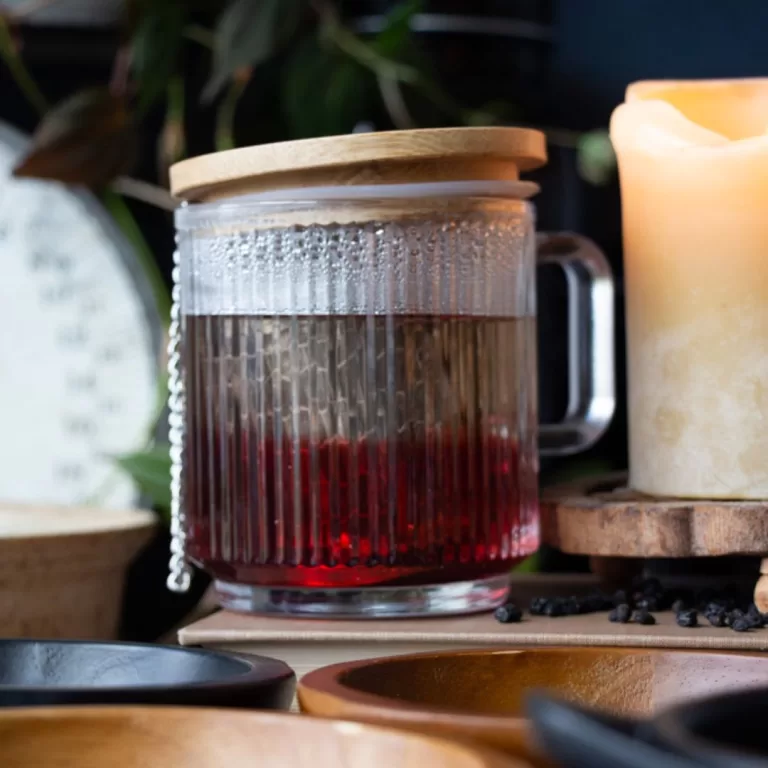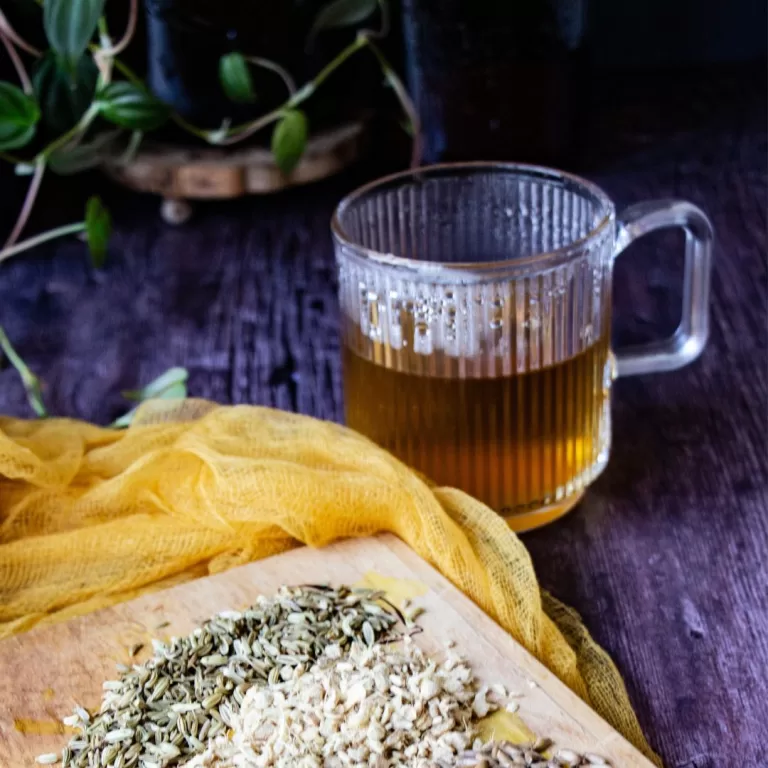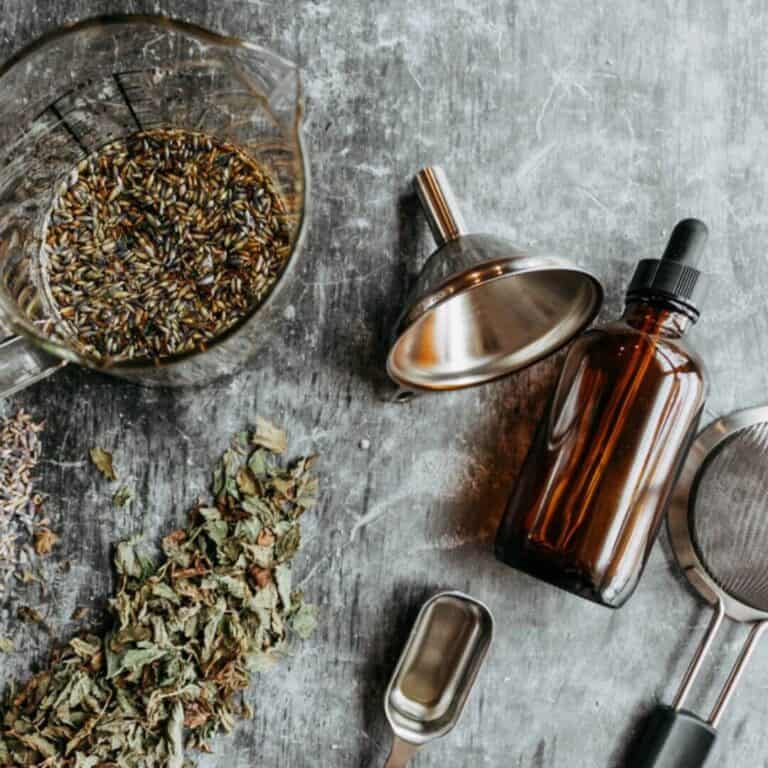How Much Mugwort for Tea? A Quick Guide to Proper Brewing
Known for its calming properties, mugwort tea can be a great addition to anyone’s daily routine. But, like with all herbal remedies, it’s essential to figure out the correct dosage in order to make the most out of its benefits without causing any unwanted side effects. With numerous sources offering advice, it might be overwhelming to know where to start.
There are so many mugwort benefits that this tea can bring! I hope you love it.
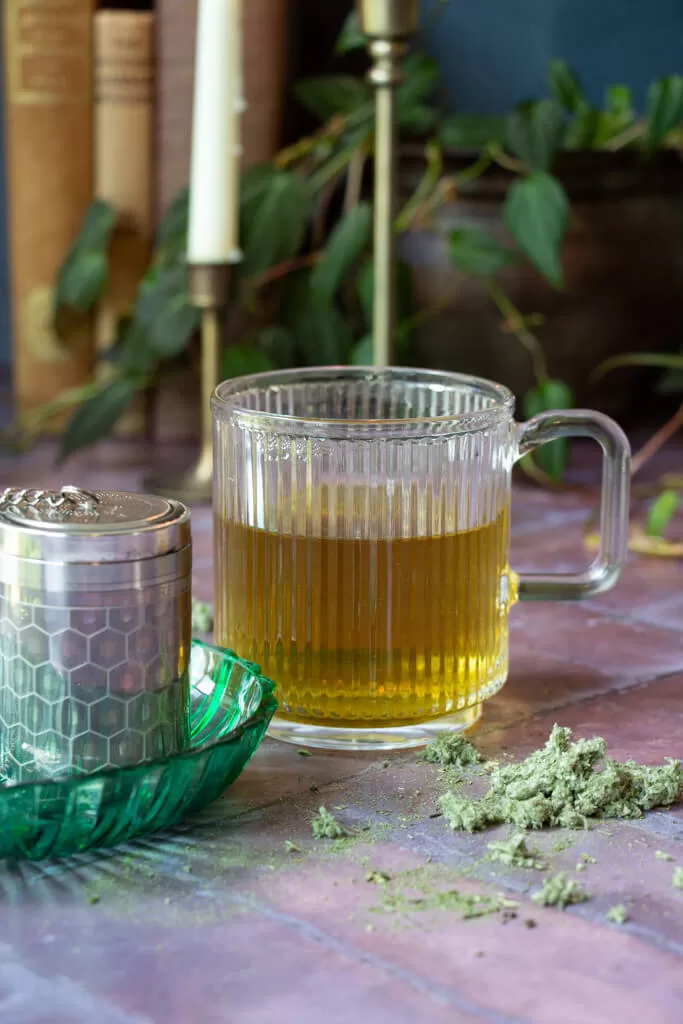
In this article, we’ll be exploring the recommended dosage of mugwort for tea and how to brew the perfect cup. I hope this information will help both newcomers and experienced users. So let’s dive into this fascinating world and learn more together about this beneficial herbal tea.
What Is Mugwort?
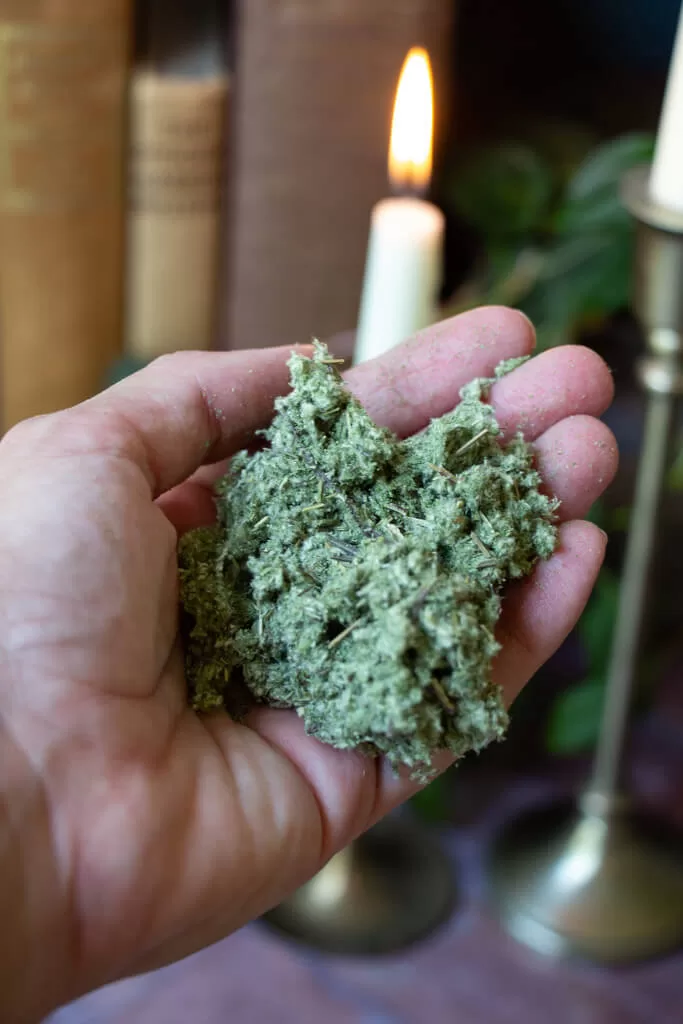
Mugwort is a perennial plant, scientifically known as Artemisia vulgaris. It is native to parts of Europe, Asia, and North Africa. However, it is now an invasive species in many other parts of the world, including North America.
Common Mugwort, the variety typically used for tea, grows along roadsides, in meadows, and near riverbanks (though I don’t recommend harvesting it from roadways due to contamination). Its leaves are commonly dried and then used to make herbal tea.
Mugwort Tea Preparation
When brewing mugwort tea, it is important to know how much to use in order to enjoy its benefits without overdoing it.
How much Mugwort for Tea?
I recommend starting with about 1 teaspoon of dried leaves per cup of boiling water, and then adjusting the amount according to taste and personal preferences.
Using Fresh Mugwort for Tea
Gather fresh leaves from the mugwort plant. I prefer using organic, pesticide-free leaves to ensure the best quality and taste. To maintain their potency and flavor, I like to store my dried leaves in an airtight container away from direct sunlight and heat sources.
Mugwort Tea Recipe
As an Amazon Associate, I earn from qualifying purchases. Please visit my privacy + disclosure page for more details.
Ingredients:
- 2 cups water
- 2 TBSP Mugwort (dried or fresh)
Holy green! This is the greenest dried mugwort that I have found on the internet and it is from Mountain Rose Herbs (not an affiliate).
Supplies:
- Tea Infuser
- Electric Kettle (You can totally use a saucepan, teapot, or whatever you want!)
For more detailed information, visit this post on methods for brewing herbal teas.
Instructions:


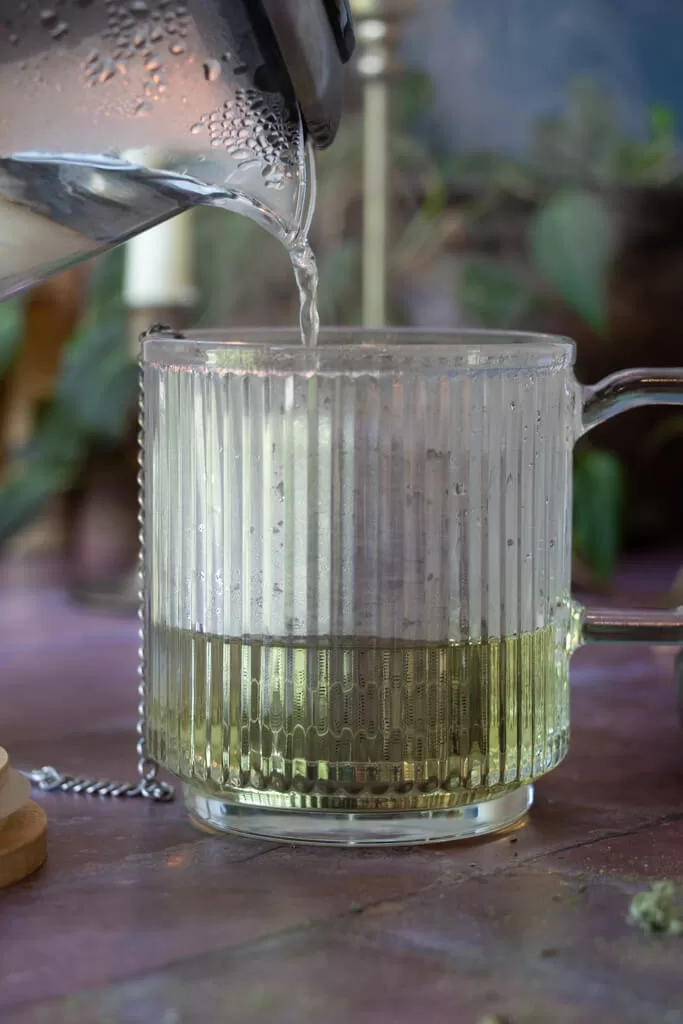

- Boil water: I begin by boiling about 2 cups of water for each mug of tea (if you use big mugs like me!).
- Measure mugwort: While the water is heating, measure out the mugwort leaves. I use about 1-2 teaspoons of dried leaves per cup, depending on how strong I want my tea. As recommended above, start with one TBSP and notice how it effects you.
- Steep the tea: Once the water just barely reaches boiling, pour it over the mugwort leaves in an infuser.
- Let the tea steep for about 5-10 minutes. The steeping time also affects the tea’s taste, so I often experiment with different durations for my preferred flavor. As mugwort can be bitter, I don’t like to steep it longer than 7 minutes.
- Strain and enjoy: After steeping, strain the tea to remove the leaves, and you’re ready to savor a cup of warm, earthy mugwort tea.
How does Mugwort Tea Taste?
In my experience, mugwort tea has a unique, slightly bitter taste with hints of earthiness and maybe even some sweetness/anise flavor. Its flavor may vary depending on the mugwort variety and brewing method. If you find it too bitter, adding honey can cut the bitterness.
Still don’t like the taste? Make a mugwort tincture instead!
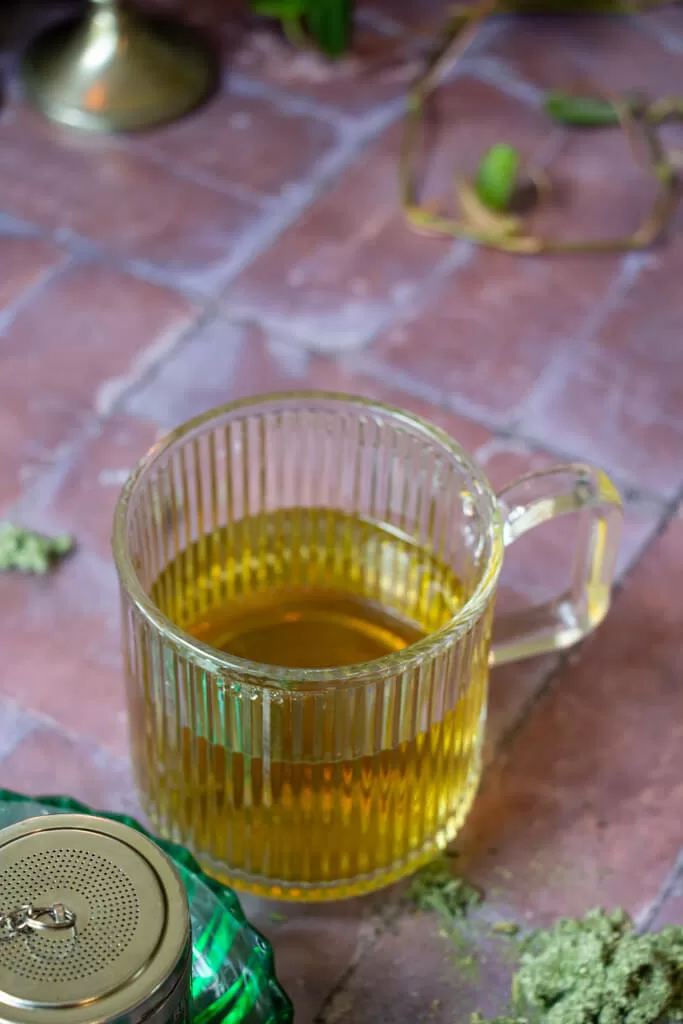
Health Benefits of Mugwort
Medical disclaimer: I am not a medical professional and I am not claiming that these herbs are a substitute for professional care. Always consult a professional for medical advice when starting natural remedies at home. These are just things that I use and love in my own home.
Below are some possible medicinal benefits for the use of mugwort.
Menstrual Support
Mugwort can be used to reduce menstrual cramps and bloating to regulate the menstrual cycle. Drinking mugwort tea may help relax the uterine muscles, easing the discomfort that often comes with irregular periods. It is also an emmenagogue that helps blood circulation flow, and a diuretic that will help reduce bloat due to water retention, which can reduce menstrual pain.
Digestive Aid
Mugwort is known to aid in digestion by stimulating the production of digestive enzymes and helping to soothe digestive issues. In traditional Chinese medicine, mugwort has been used for centuries to treat a variety of health conditions, including indigestion.
Nervous System Support
As a nervine, mugwort’s calming effects offer a natural means of supporting relaxation and reducing stress.
Lucid Dreams
Additionally, many people drink mugwort tea to help induce vivid dreams. Lucid dreaming is when you realize that you are dreaming while you are asleep.
Other Historical Uses
Mugwort has a long history of use in many cultures. According to healthline.com, “Roman soldiers put mugwort in their sandals before marching to ward off fatigue. It was also thought to protect people from wild animals and evil spirits.” In traditional medicine, mugwort has long been used for mensuration and indigestion. In California, Native Americans burn mugwort for ceremonial and medicinal purposes.
Side Effects and Safety Concerns
The following groups should avoid mugwort:
- Those with allergies to plants in the Daisy Family. Allergic reactions may include rash, Itching or hives, swelling of the face, lips, or tongue and breathing difficulties.
- Pregnant Women: Pregnant women or those planning to become pregnant soon should avoid using mugwort tincture. It may stimulate uterine contractions, which could potentially cause a miscarriage or preterm labor.
- Birth Control Users: Herbs, including mugwort, can potentially interact with hormonal contraceptives or other hormonal treatments. Some herbs may have estrogenic or progesteronic effects, which could interfere with the effectiveness or mechanisms of action of hormonal medications. It is important to ensure that there are no contraindications or potential interactions between mugwort and your specific medications.
Recommended Mugwort Dosage
When drinking mugwort tea, make sure to stay within the recommended dosage, which is typically 1-2 cups per day. To reduce the risk of side effects, it’s always a good idea to consult a healthcare professional before incorporating mugwort tea into your daily regimen.
High Doses of Mugwort
Consuming large amounts of mugwort tea may lead to problems. Some potential side effects of excessive mugwort usage include:
- Increased heart rate
- Hallucinations
- Dizziness & confusion
Other ways to enjoy Mugwort:
- Mugwort Tincture
- Mugwort Bath Soak
- Mugwort Dream Pillow
- Mugwort Lotion or Salve
For the above recipes and more, visit The Plant Wonder Collective on Instagram for seasonal herbal inspiration!
In conclusion, mugwort, a common weed with a rich history, has been used for centuries for its medicinal purposes. Today, its soothing tea offers natural support for various health concerns. Understanding the recommended dosage and proper brewing techniques allows enthusiasts to harness the potential benefits of a cup of mugwort tea. Embracing the wonders of this humble plant enables us to tap into the wisdom of traditional herbal medicine. Let the journey of mugwort tea guide you towards a deeper understanding of its healing properties and a newfound appreciation for nature’s remedies.
Pin it for Later!

More Herbal Teas:
- Cold and Flu Tea
- Allergy Tea
- Marshmallow Root Tea
- Nausea Tea
- Anxiety Tea
- Energy Tea
- Headache Tea
- Mugwort Tea
- Hangover Tea

About the Author:
I’m Brittany, totally modern and mainstream turned crunchy mama!
Read more here about how I went from a totally incompetent cook and hyper-consumer to striving to live a more meaningful life from scratch.
I can’t wait to share my modern homesteading journey with you and I hope I inspire you to join along!


